For obvious reasons Federer has been the subject of thousands of articles in the last decade. From his rise in 2003 to ascend the sport of tennis writers have struggled to capture the seemingly effortless beauty of his game. They have penned him names such as the “Swiss Maestro” to reflect his grace on the court. He has been the subject of much admiration, winning the Stefan Edberg sportsmanship award (voted on by fellow players) a record 8 times and was the Laureas World Sportsman of the Year for a record four consecutive years. Few athletes in the history of sport have dominated in the way that Federer did from 2003 until 2007. For a stretch there the “Federer Express” was virtually unstoppable, and the seeming ease with which he crushed the rest of the tennis tour left journalists scrambling for superlatives to throw at him. Yet in all of this, one thing was lacking: true analysis of Federer’s game. Not his forehand, much-studied and widely regarded as the greatest shot in the history of the sport. Not his serve, or his one-handed backhand, but his game. So much attention was put on Federer the artiste, his performances were treated as something magical, almost transcending the sport. It wasn’t just that Federer was good, he was a genius, and as such beyond normal tennis constructs. To distill his game down to winners and unforced errors was almost to do insult to the game itself.
So, it should be of little surprise when his performances waned that there should be equally little analysis taking place. Federer is getting old. He’s lost his touch. He’s lost the edge. He’s slowed a step. The variety of cheap and shallow ways to dismiss the great champion are many and yet they fail, as usual, to get to the heart of the matter. WHY was Federer so unstoppable in the first place? WHY did he start to dominate less in 2008-2009. WHY did his game seemingly drop off a cliff in 2010? Tactical Tennis was started as a blog to drive past the pretty prose and get down to the heart of tennis, and there are fewer more challenging or interesting questions than this.
So this marks the beginning of a new series called “Finding Federer.” It will look into the true reasons for Roger’s dominance that go beyond simple adjectives. We’ll look at the X’s and O’s, deconstruct some of his most successful patterns of play and ultimately get to the big question: Is Roger’s time at the top of the game over?
Along the way we’ll tackle some other interesting side topics such as the truth behind Federer’s matchup problems with Nadal, whether or not Federer should in fact change rackets, and what Federer must do in order to truly stay competitive in 2014. This series will be ambitious in its scope, and will be a mixture of technique, tactics, and mentality. It will also set the stage for some future articles on the rest of the “Big Four” in weeks to come. As always the comments section is open, and if there’s ever been a burning question you’ve wanted to ask about Federer then ask away and I may be able to roll it into an article in the series.
The Stages of Federer’s Career
Before we begin in earnest, it is important to put Federer’s career in earnest. Typically people view his career in three stages: Development, Peak and Decline. And at a glance it would be easy to classy which begins where. Up until the end of 2003 was Federer’s Development. His Peak was 2004-2009, and his Decline began in 2010. However in reality we should split his “Peak” period into two separate stages. The first, from 2004-2007 is his period of domination. 2008-2009 marked a decrease in performance, and I would mark as a stage of Early Decline. “But Tactical Tennis” I can hear you saying. “In 2008-2009 Federer made the finals of 7 out of 8 Grand Slams!” And you’d be right to point that out. However if we look at the bigger picture, Federer’s results suffered in 2008-2009 in comparison to the four-year period before it.
| Year | 2004 | 2005 | 2006 | 2007 | 2008 | 2009 | 2010 |
| Finals Made | 11 | 12 | 16 | 12 | 7 | 8 | 9 |
| Titles Won | 11 | 11 | 12 | 8 | 4 | 4 | 5 |
| Match Win % | 93 | 95 | 95 | 88 | 81 | 84 | 83 |
There are a few things that really stand out when we look at this table. The first is the drop in finals made that corresponds quite closely with the drop in overall win %. This makes a certain amount of sense – after all if we’re winning less of our matches overall it stands to reason that we will make less finals. The second is the drop in win % in the finals themselves. This is a truly good measure of where someone’s level of play is at – it stands to reason that in the final of a tournament you’ll be playing an opponent who is also in good form, having won through to the final on their side of the draw. If you are winning more than half your finals then you’re consistently doing things very well indeed. In 2004, Federer won an astounding 100% of finals played. In 2005, it dropped to an amazing 91.66%. Then 2006 sees it drop again to 75%. 2007 it drops against to 66%, then to 57% in 2008. 50% in 2009, before a small improvement to 55.5% in 2010. In truth, looking at the table you could even argue that Federer’s decline in truth began in 2007!
However in large part these small details slip through the cracks because we obsess over Grand Slam results when judging players, rather than looking at the bigger picture. The reality of it is that Federer peaked well in Grand Slams during the 2007-2009 seasons which masked an otherwise dropping performance in other tournaments.
2013: Year of Disaster
We expect our heroes to age, their performances to decline. And in the last several years people have been quick to bang the gong of Federer’s falling. In 2010 Federer’s incredible streak of Grand Slam semi-final appearances ended. In 2011 Federer finally failed to win a Grand Slam title for the first time since 2002. But 2013 was, undoubtedly, a disaster year for Federer. Not only did he fail to make a Grand Slam final for the first time in 10 years, he lost in the second round at Wimbledon. For the first time he looked vulnerable, not just to the guys in the top 20, but to the journeyman players he swatted aside like mosquitoes in his prime. He dropped matches to Daniel Brands, and Frederick Delbonis and Sergiy Stakhovsky. This wasn’t just Federer being less dominant. This was Federer looking frail. His win % for the year to date is a paltry 73%. A far cry from the days when Federer simply losing a match to *anyone* was headline news.
Is Federer done? That all depends. He has the physical and mental tools to compete with the very best and even win another Slam title or two. However several things have to come together for him to do so. But first it is time now to take a stroll down memory lane. It’s time to look at Federer in his prime, and examine just what made him so incredibly difficult to beat. And we will begin in the most unlikely of places. Not with the famous Federer Forehand, or his classic serve. But rather, with the only groundstroke in tennis with more spin than Nadal’s forehand: the Federer slice backhand.
Stay tuned for Part 2!


